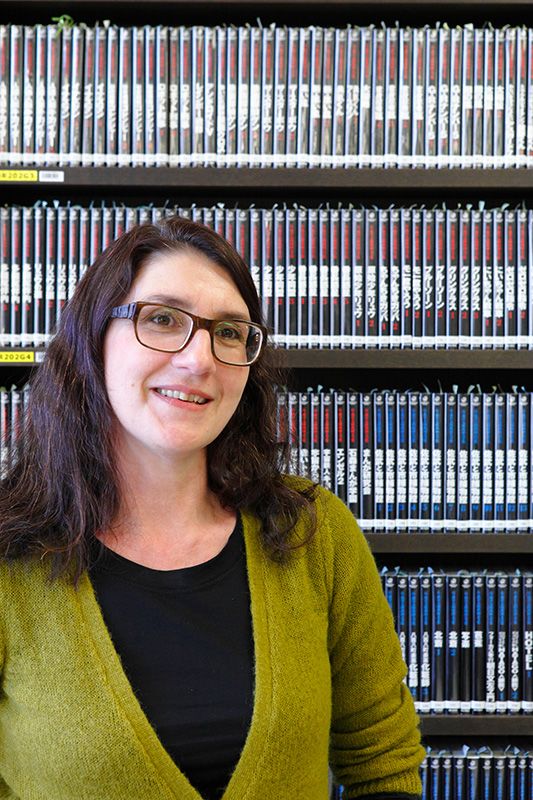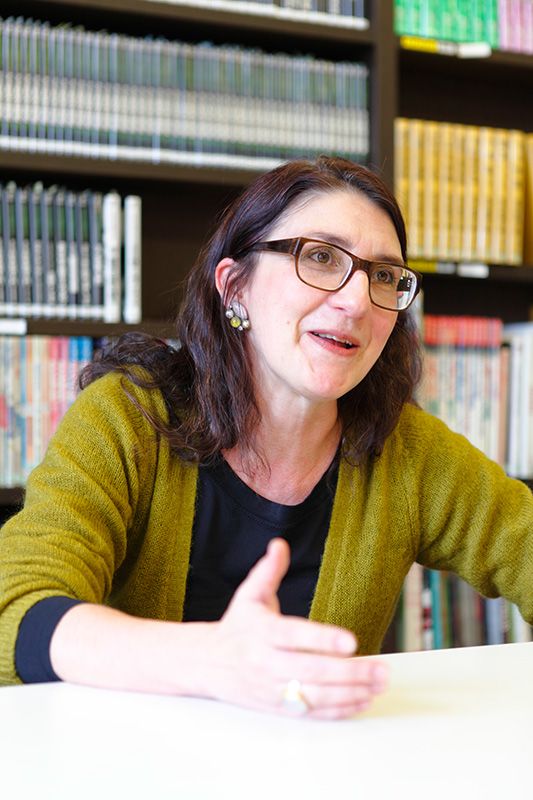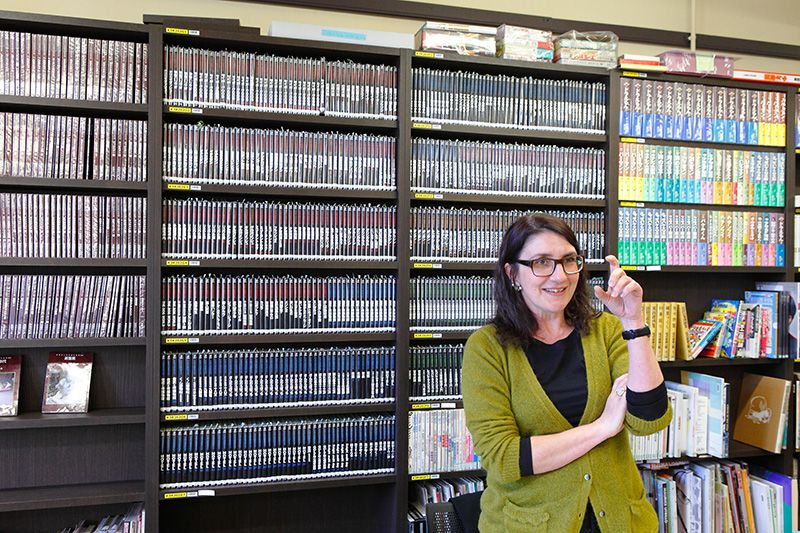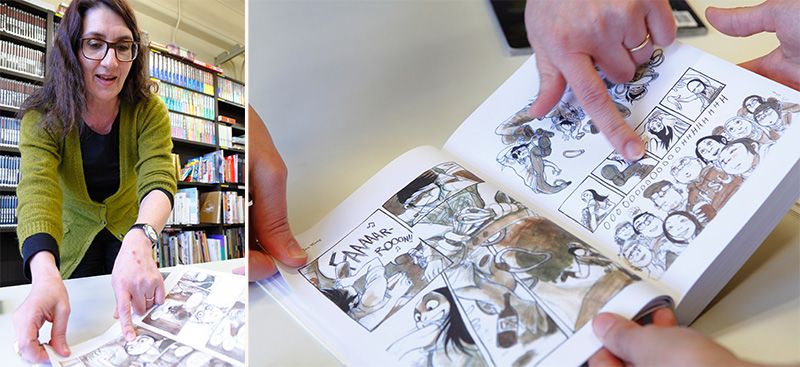
Kyoto at the Forefront of the Manga World
Manga Makes It to Academia
Culture- English
- 日本語
- 简体字
- 繁體字
- Français
- Español
- العربية
- Русский

Jaqueline BERNDT
Born in the former East Germany. Graduated with a degree in Japanese literature and fine art studies from Humboldt University of Berlin, where she also earned a PhD in art studies in 1991. After coming to Japan, worked as an instructor at Ritsumeikan University for ten years and then at Yokohama National University. In 2009, she became professor of manga studies at Kyoto Seika University, where she currently serves as the vice-director of the International Manga Research Center and the head of the Graduate School of Manga. Her main publications include the 2003 book Manga biken (A Study of Manga Aesthetics), a co-authored 2006 book titled Reading Manga: Local Perspectives on Japanese Comics, and her 2010 bilingual collection of essays Sekai no komikkusu to komikkusu no sekai (Comics Worlds and the World of Comics), as well as the 2011 article “Manga to manga, soshite geijutsu” (Manga, Manga, and Art) and the 2012 article “Manhwa, Manga, Manhua: East Asian Comics Studies.”
First Encounter with Manga
INTERVIEWER What first got you interested in manga?
JAQUELINE BERNDT To begin with, my main interests were in literature and film. I used to devour the films of Kurosawa Akira, Mizoguchi Kenji, and other Japanese directors at the film archive in Berlin. I was knocked out by the innovative composition and editing in those films. But in East Germany, where I was living at the time, we didn’t have access to contemporary films. Even the films of Ōshima Nagisa didn’t make it to East Germany in the 1980s. About the most recent work I had seen at that stage was Shindō Kaneto’s 1960 film Hadaka no shima [The Naked Island]. I wanted to learn more about contemporary Japan and find out what Japanese people of my generation were interested in. That’s when I first heard that comics were all the rage in Japan.
Around this time, I managed to get my hands on the manga series Adorufu ni tsugu [trans. Adolph; 1983–85] by Tezuka Osamu and Berusaiyu no bara [trans. The Rose of Versailles; 1972–73] by Ikeda Riyoko, thanks to a Japanese scholar of German literature who came to Germany. Both of these series deal with quite weighty topics. But they are also interspersed with some outrageous jokes. In fact, I had a hard time knowing when the content was supposed to be serious and when it was meant to be funny. The heroine of Berusaiyu no bara, for example, is a beautiful woman named Oscar. But whenever she’s surprised for some reason, her face suddenly turns ugly, as if to underline how a person’s identify is always in flux. Little touches like that really drew me in.
The only book available in English on manga in those days was Manga! Manga! The World of Japanese Comics by Frederick L. Schodt, originally published in 1983. I finished up my doctoral dissertation on manga around 1990, which happened to coincide with the reunification of East and West Germany. The prospects for academics in East Germany were not good at the time. That’s when I came to Japan, initially as a German language instructor at Ritsumeikan University, and then moving gradually into my own specialist fields of aesthetics, the sociology of art, and manga.
INTERVIEWER Increasing numbers of young people in the West and in other Asian countries are becoming interested in manga these days. What do you think accounts for the ability of manga to transcend differences of cultural background and perspective?
BERNDT Reading is essentially a private activity. But in the case of manga, the reader is part of a wider community of fans. There is also a tremendous diversity in terms of how the frames are divided, how the text is incorporated into the artwork, how characters are depicted, and so on. It really stimulates the imagination. Readers can share their reactions and responses with other enthusiasts, especially now that the Internet has made it possible for manga fans around the world to interact with each other. It’s no accident that manga has become such a global phenomenon today.
The characters in Japanese manga don’t particularly resemble real people in Japan, in part because of the influence of foreign comics on how characters have developed. This ethnic ambiguity of the characters has perhaps made it easier for people around the world to identify with Japanese manga . Another factor is the shorthand stylization of the manga drawing technique. Most children try their hand at copying the drawings they see and making their own manga. Internationally, books on how to draw manga became popular almost at the same time as the actual manga themselves. So people are not just reading manga but also using the medium to express themselves. I think a big factor in the success of manga has been how easy it is for people to participate.
Bias Against Manga Research
INTERVIEWER How would you describe the current state of manga research?
BERNDT When I first came to Japan, a lot of scholars felt that manga wasn’t really a suitable subject for academic research. At academic conferences, people in the field were looked down upon. When my dissertation appeared in Japanese, it didn’t have much impact. But things have changed. The days when manga was disparaged as second rate and not as important as research on Edo-period [1603 –1868] Japan, for example, are over.
The issue nowadays is more about how to look at manga. There is a tendency among sociologists to treat manga as simple source material or as a sort of mirror reflecting society. But this approach seems problematic to me. Manga are basically fictional and intended as entertainment. So I think there are limits to how much of a social message you can read into them. I think scholars need to understand the role of the publishing companies and their different readerships, and so on. We also need to bear in mind the differences between the nuances picked up on by regular manga readers and those that scholars focus on.
In the humanities, I get the feeling that a new sort of prejudice is growing up about manga specialists. Given the prominent position of manga within the Cool Japan strategy promoted by the Ministry of Economy, Trade, and Industry, some people have been critical of scholars who choose to specialize in manga, essentially accusing us of just being interested in the grant money. With scholars whose work has cast a critical eye on Japanese society, focusing on Japan’s war responsibility or history textbooks, for example, there’s sometimes a tendency to dismiss manga as frivolous. But despite the preconceived ideas that some scholars have, the reality is that the Japanese government is not really providing that much concrete support to manga. There are institutions of higher learning where people are taking manga seriously these days, but so far they are all private universities. And there is no national manga museum run with government funding yet either.
Cross-Disciplinary Approach to Manga
INTERVIEWER The field is still a young one. Given the relative lack of precedents to follow, what approach do you adopt to the study of manga?
 BERNDT Creating a new field of “manga studies” is not easy. Because the medium intersects such a wide variety of genres, manga needs to be examined from the perspective of methodologies from many existing fields, including psychology, economics, history, art studies, legal studies, sociology, and literary studies. Studying individual works is important too, but that on its own is not enough. We need to probe further, and examine more closely the intersections between medium, genre, and readership. We need to come up with a theoretical approach that respects the characteristics that make manga unique at the same time as incorporating the methods of traditional academic fields.
BERNDT Creating a new field of “manga studies” is not easy. Because the medium intersects such a wide variety of genres, manga needs to be examined from the perspective of methodologies from many existing fields, including psychology, economics, history, art studies, legal studies, sociology, and literary studies. Studying individual works is important too, but that on its own is not enough. We need to probe further, and examine more closely the intersections between medium, genre, and readership. We need to come up with a theoretical approach that respects the characteristics that make manga unique at the same time as incorporating the methods of traditional academic fields.
Most people who specialize in manga at universities concentrate on how manga artists learn their trade or other aspects of the creative process, but I’m more interested in the ways that manga are read. Because of the highly developed shorthand iconography of manga, which I touched on earlier, a reader can often become engrossed in a work without being consciously aware of actual expressive techniques being used. Readers don’t ask themselves “Why is this frame divided here?” when they’re reading. But if you do pay attention to these elements, and read a work more imaginatively, I think the whole experience becomes that much more interesting.
Whatever approach a scholar or graduate student might take, though, the starting point is to consider how the particular issues he or she is interested in relate to manga, and to think about the inevitability of this relationship. The ideal approach would be for the researcher to be exposed to a wide range of materials, in order to gain a good grasp of different methods of drawing and reading manga, and then carry out his or her own analysis and interpretation, thereby hopefully contributing to the social discourse on manga.
The International Manga Research Center of Kyoto Seika University, where I serve as vice director, has been holding an international manga conference every year since 2009. The aim is to increase opportunities for academic exchange in the field. We might discuss what kind of academic approach works best with a new medium of expression like manga, for example. What I’d really like to see is more inter-disciplinary interaction among scholars from a variety of fields: specialists in visual culture, “fan culture,” media studies, and so on. But so far this hasn’t been easy to bring about. When you put the focus on manga itself, you don’t attract as many scholars as when manga is used to shed light on subjects like “gender” or “Japan.”
It’s difficult sometimes to get people to communicate with one another beyond their own little worlds. This is something that can be said not just about Japanese academics but about Japanese society as a whole.
Building True Ties Beyond Economic Interests
INTERVIEWER It’s now been more than a year since the March 11 earthquake and tsunami and the nuclear disaster that followed. How has the disaster affected manga?
 BERNDT Some people in the pro–nuclear power camp are angry at manga for failing to depict nuclear power “correctly.” Setting aside for the moment the question of whether there is any such thing as a single version of the truth, it needs to be pointed out that (at least for non-educational manga) the medium is not intended to convey knowledge backed up by solid facts. Basically, manga is about communicating feeling to readers. And that often involves vagueness or exaggeration.
BERNDT Some people in the pro–nuclear power camp are angry at manga for failing to depict nuclear power “correctly.” Setting aside for the moment the question of whether there is any such thing as a single version of the truth, it needs to be pointed out that (at least for non-educational manga) the medium is not intended to convey knowledge backed up by solid facts. Basically, manga is about communicating feeling to readers. And that often involves vagueness or exaggeration.
Some people outside Japan wonder how the country that gave us the manga Hadashi no Gen [trans. Barefoot Gen; 1973–74] by Nakazawa Keiji [depicting a boy who survived the nuclear attack on Hiroshima] could have chosen the path that led to the recent nuclear disaster. But there are young Japanese kids who read that manga and say things like, “Gen is lucky because he doesn’t have to go to cram school.” In other words, people often can’t see beyond the problems in their own everyday lives. Most manga readers have no interest in linking the manga they read with social problems or politics.
I’d like to see manga works become part of a wider discussion. If I ask my students what a series like Kishimoto Masashi’s Naruto means for example, I get answers like: “It’s good for cosplay,” or “It’s a good way of making new friends.” I’d like people to think more about the deeper meaning of a manga: What can tell us about the nature of true friendship, or relations between men and women, or life itself? Broadening the ways in which manga are read is an important part of the mission of specialists in universities and museums.
In early March of 2012, as part of the annual Media Arts Festival organized by the Agency for Cultural Affairs, an international convention was held on the subject of comics as “cultural commons.” The focus was on the potential for rethinking manga as a cultural phenomenon, rather than concentrating exclusively on its importance as an export commodity or an aspect of Japanese soft power. Our discussions focused on the idea of “manga as culture.” Instead of using manga to convey to people overseas how great Japan is, the idea was for manga to serve as a medium for interaction between people in Japan—cutting across differences of generation, gender, educational backgrounds, and interest.
In terms of the Cool Japan campaign, I hope it will be about more than just economic benefits. I would like to see manga being used to help build true kizuna, ties between people.
Since last year’s disaster, manga has functioned as a forum for a diversity of voices to come together, where people can share their individual fears and anxieties, and discuss important questions: How will society as a whole survive? What kind of future to we want to build? And so on. This is what I mean by the cultural role that manga can play, and it offers something quite different from the sort of official “correct version of public opinion” put out by the main media outlets. The role of culture in the modern era has been to spur a different kind of communication from the interaction between corporations and states. The fine arts, novels, movies, and other art forms have played this role in the past. And now I think manga is capable of playing that same role.
(Originally written in Japanese. Compiled by Nippon.com from an interview with Yata Yumiko, with thanks to the Kyoto International Manga Museum. Photographs by Itō Makoto.)
manga nuclear power comics manga studies NARUTO,Cool Japan Hadashi no Gen Barefoot Gen Kyoto Seika University International Manga Research Center Jaqueline Berndt Berusaiyu no bara Rose of Versailles Adolf ni tsugu Agency for Cultural Affairs Media Arts Festival
